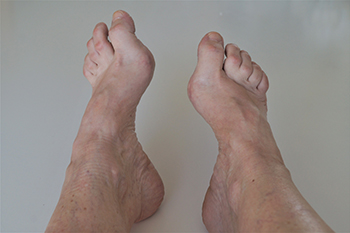Connect With Us

Ingrown toenails occur when the edges of the nail grow into the surrounding skin, causing pain, redness, and swelling. The area may become tender, and in some cases, it can become infected, leading to pus or an increased risk of complications. The primary causes of ingrown toenails include improper nail trimming, wearing tight shoes, or having naturally curved nails. This condition often results in sharp, throbbing pain, especially when pressure is applied, such as while walking or wearing shoes. A podiatrist can help by gently lifting the ingrown nail or, in more severe cases, removing part of the nail. This type of doctor may also recommend methods to prevent recurrence, such as proper nail care and footwear adjustments. If you are experiencing painful ingrown toenails, it is suggested that you schedule an appointment with a podiatrist.
Ingrown toenails may initially present themselves as a minor discomfort, but they may progress into an infection in the skin without proper treatment. For more information about ingrown toenails, contact Ali Davis, DPM of The Foot Clinic. Our doctor can provide the care you need to keep you pain-free and on your feet.
Ingrown Toenails
Ingrown toenails are caused when the corner or side of a toenail grows into the soft flesh surrounding it. They often result in redness, swelling, pain, and in some cases, infection. This condition typically affects the big toe and may recur if it is not treated properly.
Causes
- Improper toenail trimming
- Genetics
- Improper shoe fitting
- Injury from pedicures or nail picking
- Abnormal gait
- Poor hygiene
You are more likely to develop an ingrown toenail if you are obese, have diabetes, arthritis, or have any fungal infection in your nails. Additionally, people who have foot or toe deformities are at a higher risk of developing an ingrown toenail.
Symptoms
Some symptoms of ingrown toenails are redness, swelling, and pain. In rare cases, there may be a yellowish drainage coming from the nail.
Treatment
Ignoring an ingrown toenail can have serious complications. Infections of the nail border can progress to a deeper soft-tissue infection, which can then turn into a bone infection. You should always speak with your podiatrist if you suspect you have an ingrown toenail, especially if you have diabetes or poor circulation.
If you have any questions, please feel free to contact our office located in Overland Park, KS . We offer the newest diagnostic and treatment technologies for all your foot care needs.

Pressure injuries and diabetic foot wounds may look similar, but they develop differently and require distinct care. Pressure injuries, or bedsores, result from prolonged pressure on the skin, often affecting people with limited mobility. They typically form over bony areas like heels and ankles, breaking down skin and deeper tissues. Diabetic foot wounds stem from a combination of poor circulation and nerve damage. Without proper sensation, minor cuts or blisters can go unnoticed, leading to infections or even ulcers that fail to heal. These wounds are especially dangerous because diabetes impairs the body's ability to fight infections and repair tissue. Both conditions can lead to serious complications, including infection and even limb loss. If you have any type of foot wound, it is strongly suggested that you see a podiatrist for a thorough exam and appropriate treatment.
Wound care is an important part in dealing with diabetes. If you have diabetes and a foot wound or would like more information about wound care for diabetics, consult with Ali Davis, DPM from The Foot Clinic. Our doctor will assess your condition and provide you with quality foot and ankle treatment.
What Is Wound Care?
Wound care is the practice of taking proper care of a wound. This can range from the smallest to the largest of wounds. While everyone can benefit from proper wound care, it is much more important for diabetics. Diabetics often suffer from poor blood circulation which causes wounds to heal much slower than they would in a non-diabetic.
What Is the Importance of Wound Care?
While it may not seem apparent with small ulcers on the foot, for diabetics, any size ulcer can become infected. Diabetics often also suffer from neuropathy, or nerve loss. This means they might not even feel when they have an ulcer on their foot. If the wound becomes severely infected, amputation may be necessary. Therefore, it is of the upmost importance to properly care for any and all foot wounds.
How to Care for Wounds
The best way to care for foot wounds is to prevent them. For diabetics, this means daily inspections of the feet for any signs of abnormalities or ulcers. It is also recommended to see a podiatrist several times a year for a foot inspection. If you do have an ulcer, run the wound under water to clear dirt from the wound; then apply antibiotic ointment to the wound and cover with a bandage. Bandages should be changed daily and keeping pressure off the wound is smart. It is advised to see a podiatrist, who can keep an eye on it.
If you have any questions, please feel free to contact our office located in Overland Park, KS . We offer the newest diagnostic and treatment technologies for all your foot care needs.

Foot pain can stem from various conditions like corns, plantar fasciitis, and Achilles tendon injuries. Corns are thickened areas of skin that develop due to friction, often causing sharp pain when walking. Plantar fasciitis is marked by stabbing pain in the heel, especially with the first steps in the morning, caused by inflammation of the tissue connecting the heel to the toes. Achilles tendon injuries result in pain or stiffness in the back of the ankle, making movement difficult. These conditions can cause discomfort ranging from mild to debilitating, affecting daily activities. A podiatrist can help by diagnosing the exact cause of your foot pain. Treatment may include custom orthotics, stretching exercises, or injections for inflammation. In some cases, surgery may be necessary. If you are dealing with any of these conditions, it is suggested that you make an appointment with a podiatrist for effective treatment and relief.
Foot Pain
Foot pain can be extremely painful and debilitating. If you have a foot pain, consult with Ali Davis, DPM from The Foot Clinic. Our doctor will assess your condition and provide you with quality foot and ankle treatment.
Causes
Foot pain is a very broad condition that could be caused by one or more ailments. The most common include:
- Bunions
- Hammertoes
- Plantar Fasciitis
- Bone Spurs
- Corns
- Tarsal Tunnel Syndrome
- Ingrown Toenails
- Arthritis (such as Gout, Rheumatoid, and Osteoarthritis)
- Flat Feet
- Injury (from stress fractures, broken toe, foot, ankle, Achilles tendon ruptures, and sprains)
- And more
Diagnosis
To figure out the cause of foot pain, podiatrists utilize several different methods. This can range from simple visual inspections and sensation tests to X-rays and MRI scans. Prior medical history, family medical history, and any recent physical traumatic events will all be taken into consideration for a proper diagnosis.
Treatment
Treatment depends upon the cause of the foot pain. Whether it is resting, staying off the foot, or having surgery; podiatrists have a number of treatment options available for foot pain.
If you have any questions, please feel free to contact our office located in Overland Park, KS . We offer the newest diagnostic and treatment technologies for all your foot care needs.

High arches can contribute to several foot and ankle problems due to the uneven distribution of weight. People with this condition often experience excessive pressure on the ball and heel of the foot, which can lead to metatarsalgia or plantar fasciitis. The strain placed on the toes may also result in deformities, such as hammer toe or claw toe, making it difficult to wear regular shoes without discomfort. High arches can also cause instability in the foot and ankle, which increases the risk of frequent sprains. Some people are born with high arches, while others develop them due to neurological conditions that affect muscle function. A podiatrist can assess your foot structure, determine whether an underlying condition is involved, and provide recommendations to improve stability and reduce pain. Treatment may involve supportive footwear, custom orthotics, or surgery, if the condition leads to chronic pain or deformity. If you have high arches that are causing foot or ankle pain, it is suggested that you schedule an appointment with a podiatrist for an exam and treatment options.
If you have any concerns about your feet, contact Ali Davis, DPM from The Foot Clinic. Our doctor can provide the care you need to keep you pain-free and on your feet.
Biomechanics in Podiatry
Podiatric biomechanics is a particular sector of specialty podiatry with licensed practitioners who are trained to diagnose and treat conditions affecting the foot, ankle and lower leg. Biomechanics deals with the forces that act against the body, causing an interference with the biological structures. It focuses on the movement of the ankle, the foot and the forces that interact with them.
A History of Biomechanics
- Biomechanics dates back to the BC era in Egypt where evidence of professional foot care has been recorded.
- In 1974, biomechanics gained a higher profile from the studies of Merton Root, who claimed that by changing or controlling the forces between the ankle and the foot, corrections or conditions could be implemented to gain strength and coordination in the area.
Modern technological improvements are based on past theories and therapeutic processes that provide a better understanding of podiatric concepts for biomechanics. Computers can provide accurate information about the forces and patterns of the feet and lower legs.
Understanding biomechanics of the feet can help improve and eliminate pain, stopping further stress to the foot.
If you have any questions please feel free to contact our office located in Overland Park, KS . We offer the newest diagnostic and treatment technologies for all your foot and ankle needs.
Blog Archives
- March 2025
- February 2025
- January 2025
- December 2024
- November 2024
- October 2024
- September 2024
- August 2024
- July 2024
- June 2024
- May 2024
- April 2024
- March 2024
- February 2024
- January 2024
- December 2023
- November 2023
- October 2023
- September 2023
- August 2023
- July 2023
- June 2023
- May 2023
- April 2023
- March 2023
- February 2023
- January 2023
- December 2022
- November 2022
- October 2022
- September 2022
- August 2022
- July 2022
- June 2022
- May 2022
- April 2022
- March 2022
- February 2022
- January 2022
- December 2021
- November 2021
- October 2021
- September 2021
- August 2021
- July 2021
- June 2021
- May 2021
- April 2021
- March 2021
- February 2021
- January 2021
- December 2020
- November 2020
- October 2020
- September 2020
- August 2020
- July 2020
- June 2020
- May 2020
- April 2020
- March 2020
- February 2020
- January 2020
- December 2019
- November 2019
- October 2019
- September 2019
